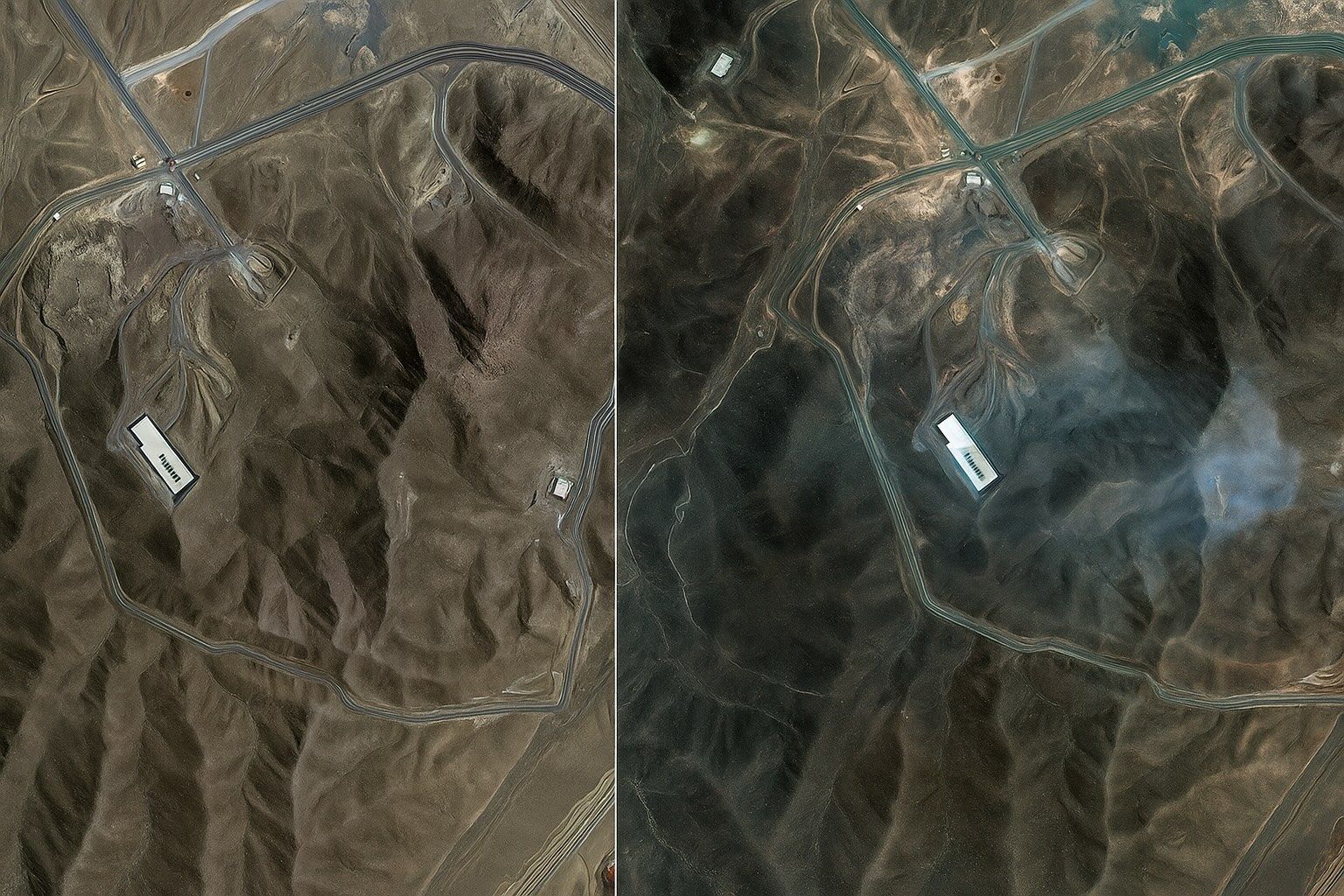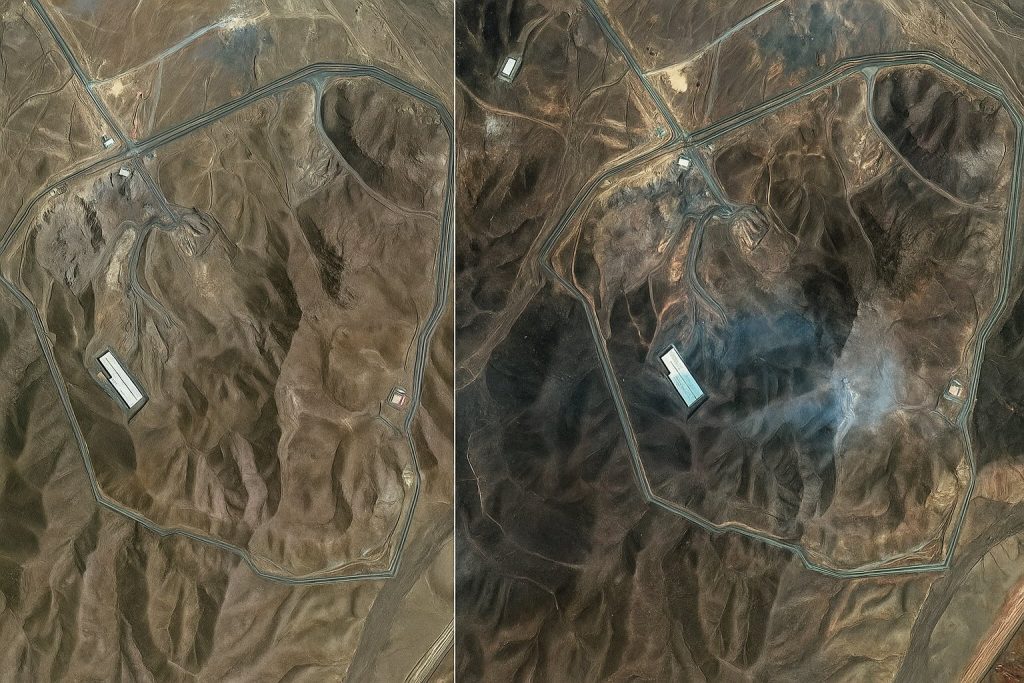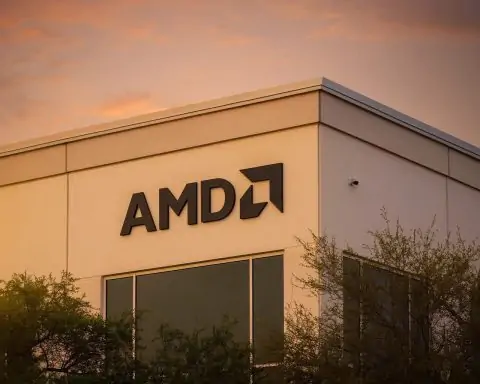- Shortly after 02:00 local time on 22 June, seven U.S. B‑2 Spirit bombers dropped 14 MOPs on Fordow with Tomahawks suppressing Iranian SAM sites.
- Maxar/Planet imagery shows six precisely spaced entry craters along the ridge above the centrifuge halls, forming a textbook double‑tap pattern consistent with the MOP fuse sequence.
- Damage signatures include collapsed tunnel portals, landslide debris, scorched support buildings, and dust plumes obscuring the cliff face and vent shafts.
- Fordow is carved 80–100 m inside Kuh‑e‑Fordow mountain, reinforced by concrete and IRGC air‑defence rings, and was designed for 3,000 centrifuges with IR‑6 cascades enriching to 60%.
- IAEA Director‑General Rafael Grossi urged an inspection corridor after saying damage is very significant and verification is essential.
- Tehran’s state media claim limited surface damage and operational centrifuge halls, while independent imagery shows no power or ventilation since 16 June.
- About 408 kg of 60% enriched uranium remain unaccounted for after the strike, fueling speculation it was moved to an undisclosed tunnel network near Esfahan.
- Iran’s parliament is weighing withdrawal from the Nuclear Non‑Proliferation Treaty, potentially cutting IAEA access.
- Analysts watch the Kolang Gaz La mountain tunnels south of Natanz as a possible fallback enrichment hub if Fordow cannot be rebuilt.
- Fordow has been described by analysts as “the be‑all and end‑all of Iran’s nuclear operation,” underscoring its strategic importance.
Recent commercial satellite photographs released by Maxar Technologies, Planet Labs and multiple newsrooms confirm that the [1] outside Qom—the deepest, most heavily‑fortified node in Iran’s nuclear network—absorbed direct hits from U.S. Massive Ordnance Penetrator (MOP) bombs during the 22 June allied air‑raid. High‑resolution before‑and‑after imagery shows at least six fresh penetrator holes in the limestone ridge above the centrifuge halls, collapsed tunnel portals, landslide debris and scorched support buildings, leading independent analysts and even the U.N. nuclear‑watchdog chief to conclude that “very significant damage” has almost certainly incapacitated the site. Yet Tehran’s denial of catastrophic loss, evidence of last‑minute truck convoys, and the unresolved question of where 408 kg of 60 % enriched uranium went leave the international community guessing whether Fordow’s destruction is a decisive setback or merely a costly pause in Iran’s march toward a bomb. [2] [3] [4] [5]
1. How the World Learned: The Satellite Intelligence
- Maxar/Planet imagery – Yesterday’s Maxar pass revealed six precisely‑spaced entry craters along the ridge line, a textbook “double‑tap” pattern matching the 30,000‑lb MOP’s two‑stage fuse sequence. [6]
- Damage signatures – Dust plumes obscuring the cliff face and collapsed ventilation shafts are visible in the 22 June images published by Business Insider and Wired, suggesting internal voids imploded after blast over‑pressure propagated downward. [7] [8]
- Comparative overlays – A Washington Post graphic places the new craters directly above the two underground enrichment halls mapped by the IAEA, confirming that strike planners targeted the centrifuge cascades rather than ancillary labs. [9]
2. Fordow in Context: The Underground Fortress
Commissioned secretly in 2006 and publicly acknowledged in 2009, Fordow is carved 80‑100 m inside Kuh‑e‑Fordow mountain, buffered by reinforced concrete and IRGC air‑defence rings. Designed for 3,000 centrifuges, it recently ran tandem IR‑6 cascades enriching uranium to 60 %. [10] [11]
Analysts long called it “the be‑all and end‑all of Iran’s nuclear operation,” a phrase coined by Behnam Ben Taleblu of the Foundation for Defense of Democracies. [12]
3. The Night of the Strikes: Weapons and Timeline
Shortly after 02:00 local time on 22 June, seven U.S. B‑2 Spirit bombers under Operation Midnight Hammer dropped 14 MOPs on Fordow, Natanz and Isfahan, while Tomahawk missiles suppressed Iranian SAM sites. [13] [14]
Israel’s earlier 13 June Rising Lion raids had deliberately spared Fordow, focusing on air‑defence nodes—a sequencing echoed in the Institute for Science and International Security’s post‑strike memo. [15]
4. Damage Assessment from Space
| Feature | Pre‑Strike | Post‑Strike | Interpretation |
|---|---|---|---|
| Ridge directly above Halls A/B | Intact limestone | Six 5–6 m craters, ground subsidence | Penetration to ~60 m depth before detonation [16] |
| West tunnel portal | Clear roadway | Portal buried under rockslide, scorched vegetation | Shockwave collapsed access shaft [17] |
| Vent stack array | 4 vents visible | 2 vents missing, debris ring | Internal blast blow‑back damaged ducting [18] |
| Support compound | Fuel depot, guard towers intact | Multiple roofs sheared, soot trails | Secondary fires & over‑pressure [19] |
Planet Labs imagery from 14 June captured an unusual queue of 14 trucks outside the main gate, indicating Iran may have evacuated sensitive inventory days before the raid. [20]
5. Competing Narratives
- Tehran’s line – State media claims “limited surface damage” and boasts centrifuge halls remain “operational.” [21] [22]
- Open‑source rebuttal – Independent imagery shows collapsed portals and a dust‑blanketed ridge; The Times of Israel notes analysts found no signs of power or ventilation since 16 June. [23]
- Regional press – The Week and Gulf News highlight the psychological blow: Fordow was marketed domestically as indestructible. [24] [25]
6. What the Experts Say
“They just punched through with these MOPs… I would expect that the facility is probably toast.” — David Albright, former U.N. inspector. [26]
“There are almost certainly facilities we don’t know about.” — Jeffrey Lewis, Middlebury Institute, warning of an underground dispersal strategy. [27]
“Very significant damage is likely, but inspectors must get in to verify.” — Rafael Grossi, IAEA Director‑General, urging an inspection corridor. [28]
“Fordow is the be‑all and end‑all of Iran’s nuclear operation.” — Behnam Ben Taleblu, FDD. [29]
7. The Missing Uranium Question
The Financial Times reports that 408 kg of 60 % enriched uranium—enough for roughly seven crude weapons if further enriched—cannot be accounted for after the strike, fuelling speculation Iran relocated it to an undisclosed tunnel network near Esfahan. [30]
Reuters cites U.S. and Israeli officials who fear the material “may have been moved under the radar” and could accelerate a covert breakout. [31]
8. Diplomatic & Security Fallout
- Iran’s parliament is weighing withdrawal from the Nuclear Non‑Proliferation Treaty (NPT), a move that would strip the IAEA of legal access. [32]
- Gulf states have begun radiation monitoring but experts like Scott Roecker (NTI) downplay fallout risk since Fordow stored “fresh,” not irradiated, fuel. [33]
- Washington has signalled further strikes if inspectors are blocked—echoed by President Trump’s warning that Tehran must “seek peace or face more attacks.” [34]
9. Key Unknowns
- Structural survivability – Did the MOPs reach Hall B’s 90 m depth or collapse just the access drifts?
- Centrifuge status – Without electricity and HVAC since 22 June, thousands of IR‑6 machines may have seized irreparably, but verification is pending.
- Uranium whereabouts – The fate of the 60 % stockpile will determine whether Iran can mount a rapid rebuild.
- Next target set – Analysts watch the still‑intact Kolang Gaz La mountain tunnels south of Natanz as a possible fallback enrichment hub. [35]
Further Reading (selected)
- Maxar imagery package via Business Insider. [36]
- Reuters interactive on strike damage. [37]
- IAEA emergency board transcript. [38]
- Institute for Science and International Security strike analysis. [39]
- Washington Post satellite visuals explainer. [40]
Bottom line: Fordow’s once‑mythical invulnerability has been shattered in the public eye, but the strategic outcome hinges on what Iran managed to spirit away before the bombs landed—and whether inspectors ever get close enough to confirm that the heart of Tehran’s enrichment effort really is “toast.”
References
1. maps.app.goo.gl, 2. omni.se, 3. www.reuters.com, 4. www.wsj.com, 5. www.ft.com, 6. www.reuters.com, 7. www.businessinsider.com, 8. www.wired.com, 9. www.washingtonpost.com, 10. gulfnews.com, 11. www.aljazeera.com, 12. dnyuz.com, 13. www.businessinsider.com, 14. www.businessinsider.com, 15. isis-online.org, 16. www.reuters.com, 17. www.sfgate.com, 18. www.timesofisrael.com, 19. www.israelnationalnews.com, 20. www.reuters.com, 21. www.ynetnews.com, 22. www.thevibes.com, 23. www.timesofisrael.com, 24. www.theweek.in, 25. gulfnews.com, 26. www.reuters.com, 27. www.reuters.com, 28. www.wsj.com, 29. dnyuz.com, 30. www.ft.com, 31. www.reuters.com, 32. www.reuters.com, 33. en.protothema.gr, 34. www.thevibes.com, 35. isis-online.org, 36. www.businessinsider.com, 37. www.reuters.com, 38. www.wsj.com, 39. isis-online.org, 40. www.washingtonpost.com










